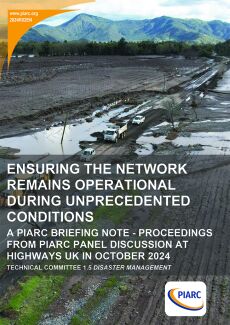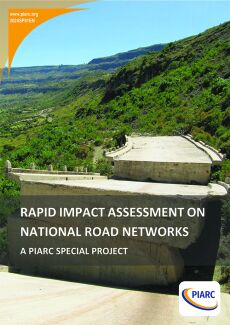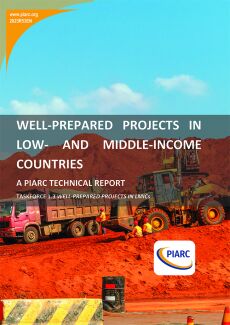Technical Reports Risk management
This page lists technical reports of PIARC in the field of risk management. These publications are classified chronologically.
-
Challenges In Resilience Building For Road Disaster Management Coordination And Cooperation In Different Regions - Summary of PIARC & REAAA Joint Session at the IARC Osaka Workshop, May 2025

The international workshop was organized by the World Road Association (PIARC) through its Technical Committee 1.5, "Disaster Management," and the Japan Road Association (JARA). The Road Engineering Association of Asia and Australasia (REAAA) collaborated with the event through its Climate Change, Resilience, and Disaster Management Committee. The workshop theme was "Road Disaster Management: Enhancing Coordination, Cooperation, and Diversity". This event provided information on the latest disaster [...]
-
Ensuring the Network Remains Operational during Unprecedented Conditions - Proceedings from Piarc Panel Discussion at Highways UK in October 2024

Members of PIARC TC 1.5 Disaster Management from across the globe were asked to present and participate in a panel discussion at Highways UK in October 2024 : “PIARC Disaster Management Committee Panel: Ensuring the network remains operational during unprecedented conditions.” Highways UK is a major event for the highways and transportation industry in the UK that provides a conference, exhibition, and networking opportunities. This briefing note provides details on the thought provoking, [...]
-
Rapid Impact Assessment in the Highway Sector

Most road networks around the world are impacted by natural and man-made hazards. Natural hazards are mostly climate- and geologically-induced, and landslides, debris flows, inland and coastal floods, earthquakes and drifting snow are among the most common. Man-made hazards include collisions and sabotage, for example, while forest fires can be sparked by extreme heat and careless or intentional ignition by the general public. The more severe of these hazards can impact large areas for long durations, [...]
-
Well-Prepared Projects in Low- and Middle-Income Countries - A PIARC Technical Report

The issue of good preparation of road projects was already dealt with by PIARC Taskforce 1.1 in 2020 and 2021. However, contacts with major organizations concerned, such as Multilateral Development Banks (MDBs), were made difficult during the pandemic. Also, the number of representatives from Low- and Middle-Income Countries (LMICs) in the Taskforce was very limited. These circumstances did not allow the Taskforce to consider the specific case of road projects prepared in LMICs. PIARC therefore [...]
-
Disaster Management and Recovery Techniques for Road Administrators - Technical Report

Road networks are one of the most important infrastructure elements that support all kinds of socio-economic activities. In the case of disasters, the role of a road network is more crucial. The purpose of road disaster management is to increase resilience of road networks, effectively and efficiently. Resilience of road networks include not only resilience of the network itself (e.g., planning and construction of alternative road network or alternative transportation) but resilience of road facilities [...]
1 / 35
- Previous
- Next